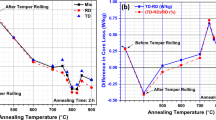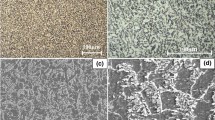Abstract
The evolution of the martensite content is monitored throughout uniaxial tensile experiments on anisotropic temper-rolled stainless steel 301LN. Several martensite content measurement techniques are discussed. It is found that micrography, basic X-ray diffraction and EBSD provide good qualitative results, but the absolute errors in the estimated absolute martensite content can be greater than 10%. Magnetic saturation induction measurements provide the spatial average of the martensite content over a large volume, which eliminates inaccuracies associated with metallographic surface preparation. Inverse magnetostriction of the ferromagnetic martensitic phase has a strong effect on the results from magnetic permeability measurements. It is critically important to remove all elastic strains before measuring the magnetic permeability. Neutron diffraction is used to quantify the residual lattice strains in the martensite after removing all macroscopic elastic strains. The results demonstrate that the linear relationship between the magnetic permeability and the martensite content holds true despite the presence of small residual strains. In situ measurements of the martensite content evolution during tensile tests along the rolling, the cross-rolling and the 45° direction of the anisotropic sheet material reveal that the transformation kinetics are independent of the loading direction in stainless steel 301LN under uniaxial tension.









Similar content being viewed by others
Notes
This output signal corresponds to the ferrite content when ferrite is the only ferromagnetic phase of the sample.
References
Jacques PJ, Furnemont Q, Lani F, Pardoen T, Delannay F (2007) Multiscale mechanics of TRIP-assisted multiphase steels: II Micromechanical modeling. Acta Mater 55(11):3695–3705
Angel T (1954) Formation of martensite in austenitic stainless steels, effect of deformation, temperature and composition. J Iron Steel Inst 177:165–174
Lecroisey F, Pineau A (1972) Martensitic transformations induced by plastic deformation in the Fe–Ni–Cr–C system. Metall Trans 3(2):387
Olson GB, Cohen M (1975) Kinetics of strain-induced martensitic nucleation. Metall Mater Trans A 6(3):791–795
Stringfellow RG, Parks DM, Olson GB (1992) A constitutive model for transformation plasticity accompanying strain-induced martensitic transformations in metastable austenitic steels. Acta Metall 40(7):1703
Greenwood GW, Johnson RH (1965) The deformation of metals under small stresses during phase transformation. Proc Roy Soc A283:403
Zhao L, van Dijk NH, Bruck E, Sietsma J, van der Zwaag S (2001) Magnetic and X-ray diffraction measurements for the determination of retained austenite in TRIP steels. Mater Sci Eng A 313(1–2):145–152
Smaga M, Walther F, Eifler D (2008) Deformation-induced martensitic transformation in metastable austenitic steels. Mater Sci Eng A 483–484:394–397
Post J, Nolles H, Datta K, Geijselaers HJM (2008) Experimental determination of the constitutive behavior of a metastable austenitic stainless steel. Mater Sci Eng A 498:179–190
Radu M, Valy J, Gourgues AF, Le Strat F, Pineau A (2005) Continuous magnetic method for quantitative monitoring of martensitic transformation in steels containing metastable austenite. Scr Mater 52:525–530
Talonen J, Aspegren P, Hanninen H (2004) Comparison of different methods for measuring strain induced alpha ’-martensite content in austenitic steels. Mater Sci Technol 20(12):1506–1512
Mohr D, Jacquemin J (2008) Large deformation of anisotropic austenitic stainless steel sheets at room temperature: multi-axial experiments and phenomenological modeling. J Mech Phys Solids 56(10):2935–2956
Jenkins R, Snyder R (1996) Introduction to X-ray powder diffractometry. Wiley-Interscience
Hecker SS, Stout MG, Staudhammer KP, Smith LJ (1982) Effects of strain state and strain rate on deformation-induced transformation in 304 stainless steel: Part I. Magnetic measurements and mechanical behavior. Metall Trans A 13A:619–626
Bozorth R (1951) Ferromagnetism. New York, United States
Villari E (1865) Change of magnetization by tension and by electric current. Annu Rev Phys Chem 126:87–122
Morishita K, Gilanyi A, Sukegawa T, Uesaka T, Miya K (1998) Magnetic non-destructive evaluation of accumulated fatigue damage in ferromagnetic steels for nuclear plant component. J Nucl Mat 258–263:1946–1952
Allen AJ, Hutchings MT, Windsor CG (1985) Neutron diffraction methods for the study of residual stress fields. Adv Phys 34(4):445–473
Allen AJ, Bourke MAM, Dawes S, Hutchings MT, Withers PJ (1992) The analysis of internal strains measured by neutron diffraction in Al/SiC metal matrix composites. Acta Metall Mater 40(9):2361–2373
Brown EN, Rae PJ, Dattelbaum DM, Clausen B, Brown DW (2008) In situ measurement of crystalline lattice strains in polytetrafluoroethylene. Exp Mech 48:119–131
Noyan IC, Brugger A, Betti R, Clausen B (2010) Measurement of strain/load transfer in parallel seven-wire strands with neutron diffraction. Exp Mech 50:265–272
Proust G, Kaschner GC, Beyerlein IJ, Clausen B, Brown DW, McCabe RJ, Tome CN (2010) Detwinning of high-purity zirconium: in situ neutron diffraction experiments. Exp Mech 50:125–133
Santacreu PO, Glez JC, Chinouilh G, Frohlich T (2006) Behaviour model of austenitic stainless steels for automotive structural parts. Steel Res Int 77(9–10):714
Kocks UF, Tome CN, Wenk H-R (1998) Texture and anisotropy: preferred orientations in polycrystals and their effect on materials properties. Cambridge, United Kingdom
Acknowledgement
Thanks are due to Dr. Pierre-Olivier Santacreu and Benoit Proult of ArcelorMittal for valuable discussions and their help on the martensite content measurements. Dr. Eva Heripre from LMS is thanked for performing the EBSD measurements. Thanks are also due to Dr. Scott Speakman of MIT for assistance with X-ray diffraction analysis, as well as Dr. Camden Hubbard, Josh Schmidlin, and Brian Cady at ORNL for their assistance in carrying out the neutron diffraction experiments. This work made use of the MRSEC Shared Experimental Facilities supported by the National Science Foundation under award number DMR-0819762. Neutron diffraction research sponsored by the Assistant Secretary for Energy Efficiency and Renewable Energy, Office of FreedomCAR and Vehicle Technologies, as part of the High Temperature Materials Laboratory User Program, Oak Ridge National Laboratory, managed by UT-Battelle, LLC, for the U.S. Department of Energy under contract number DE-AC05-00OR22725. The partial support of the MIT Fracture Consortium on Advanced High Strength Steels is gratefully acknowledged. Allison Beese was supported by the Department of Defense (DoD) through the National Defense Science & Engineering Graduate Fellowship (NDSEG) Program.
Author information
Authors and Affiliations
Corresponding author
Rights and permissions
About this article
Cite this article
Beese, A., Mohr, D. Identification of the Direction-Dependency of the Martensitic Transformation in Stainless Steel Using In Situ Magnetic Permeability Measurements. Exp Mech 51, 667–676 (2011). https://doi.org/10.1007/s11340-010-9374-y
Received:
Accepted:
Published:
Issue Date:
DOI: https://doi.org/10.1007/s11340-010-9374-y




